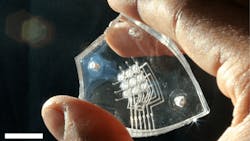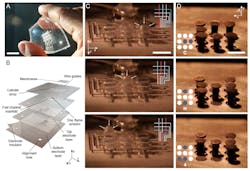Spark-Initiated Mini-Explosions Pop Tiny Braille-Reader Dots
What you’ll learn:
- The problems associated with, and possible solutions to, creating miniature pop-up dots as a tactile indicator surface for Braille readers.
- How a system using elastomeric bumps that are “popped” by spark-initiated, methane-based mini-explosions may be a viable solution.
- How such a system was constructed and evaluated as a small array, as well as the associated multidisciplinary scientific analysis.
Devising a fast-response tactile Braille display for vision-impaired users, in which the dots rise and then return flush (or nearly so) to the surface, is an electronic-motion challenge. Among the issues is that a usable Braille-text display needs a large number of tiny dots (1-3 mm diameter) with very tight pitch (about 5 mm). A full-page Braille display (25 lines, 40 cells per line) has 6,000 dots, clearly not a setting for conventional electromechanically actuated solutions.
While soft pneumatic-based actuators initially showed promise in small-resolution conformable tactile displays, they’re not practical since their control valves are bulkier than the actuators themselves.
Other alternatives also have limitations: thermal actuators usually take seconds to finish a heating/cooling “work loop” cycle in the absence of thermal-management accessories (because of heat-transport limitations); pulsed electromagnetic systems suffer from low actuation forces and interference between individual actuators (crosstalk) when shrunk down to the size of a Braille dot; and piezoelectric devices have large production costs at scale and need longer, cantilevered geometries that impede their ability to be arranged in a densely packed array.
Now, a collaboration of researchers at Cornell University and Technion-Israel Institute of Technology has devised and tested a radically different approach. They used tiny electrodes to ignite a microvolume of premixed methane and oxygen, thus causing a thin silicone membrane to inflate (Fig. 1).
The controlled “explosion” can be directed via independent channels to raise specific dots for a highly tactile indication (note: this isn’t the same as haptics). A magnetic latching system gives these dots a post-ignition persistence, but they can be reset simply by pressing them down.
Sparking Traces
Key to the new system is an array of molded silicone and microfluidic liquid-metal traces that function as electrodes to produce sparks to ignite a lean methane-oxygen fuel mixture in a 5-mm-diameter, 2-mm-tall silicone cylinder. The exothermic reaction quickly pressurizes the cylinder, displacing the silicone membrane up to 6 mm in under 1 ms. At these small scales, the wall-quenching flame behavior allowed researchers to construct a 3 × 3 array of 3-mm diameter cylinders with 4-mm pitch (Fig. 2).
Further, the fluidic elastomer actuators cool quickly and very little fuel is required, so they maintain that a commercial version would be safe despite potential misgivings about methane from prospective users. Among the many non-obvious issues the team had to resolve was the risk of spark-initiated “flashback”—a well-known concern in larger piping. Here, they had to develop and install a small-scale, 1.5-mm-thick, sintered metal disk in the central junction of the fuel channels to prevent it.
They demultiplexed the voltages via high-voltage reed relays arranged on two small copper PCB prototyping plates, after testing for individual spark control (Figs. 3 and 4), crosstalk, and inductive-kick issues. Relay switching was controlled via Arduino Uno digital output ports. Although the researchers didn’t explicitly call out the voltage they used in their published paper, their isolated dc-dc supply is rated for a 2-kV, 250-µA output.
Electromechanical vs. Combustion
“Having something that can change its shape in a way you can feel, like real objects, doesn’t exist right now. There’s this tradeoff between having small actuators, and size and weight and cost. It’s so difficult,” said Rob Shepherd, project head and associate professor of mechanical and aerospace engineering in the Cornell College of Engineering. “Everybody’s been trying electromechanical systems. So we said, well, what if we don’t do that at all and we use combustion. Small volumes of gas can create powerful outputs.”
The current system consists of nine fluidic elastomer actuators, but the researchers are hoping to scale that up and eventually create a full electronic tactile display. They also plan to convert the system to widely available butane, already used in countless pocket lighters.
The research was supported by the National Science Foundation, the Air Force Office of Scientific Research and the Sloan Foundation. Full details are in their paper “Valveless Microliter Combustion for Densely Packed Arrays of Powerful Soft Actuators” published in the Proceedings of the National Academy of Sciences. While that paper is behind a paywall, an open version is fortunately available here.
In addition, a Supporting Information File links to a 23-page report that may have more interest to engineers than the main paper. It contains details of the materials used, fabrication steps and techniques, test arrangements, a quantitative table with specifics comparing this approach with respect to various parameters versus other approaches, as well as relevant chemistry, fluid mechanics, and physics equations. It also includes links to six short videos.
About the Author

Bill Schweber
Contributing Editor
Bill Schweber is an electronics engineer who has written three textbooks on electronic communications systems, as well as hundreds of technical articles, opinion columns, and product features. In past roles, he worked as a technical website manager for multiple topic-specific sites for EE Times, as well as both the Executive Editor and Analog Editor at EDN.
At Analog Devices Inc., Bill was in marketing communications (public relations). As a result, he has been on both sides of the technical PR function, presenting company products, stories, and messages to the media and also as the recipient of these.
Prior to the MarCom role at Analog, Bill was associate editor of their respected technical journal and worked in their product marketing and applications engineering groups. Before those roles, he was at Instron Corp., doing hands-on analog- and power-circuit design and systems integration for materials-testing machine controls.
Bill has an MSEE (Univ. of Mass) and BSEE (Columbia Univ.), is a Registered Professional Engineer, and holds an Advanced Class amateur radio license. He has also planned, written, and presented online courses on a variety of engineering topics, including MOSFET basics, ADC selection, and driving LEDs.




